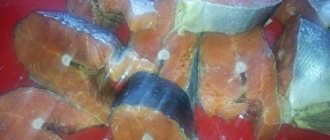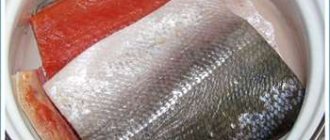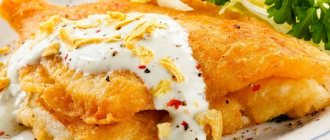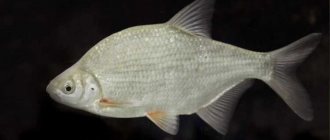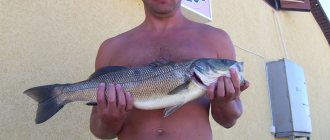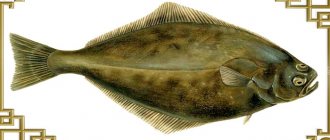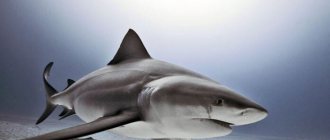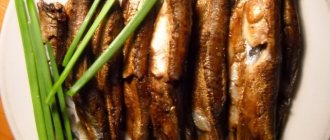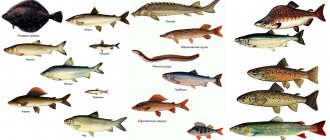Fish of the northern seas - features and advantages
The lover of cold waters lives in the bays of the Arctic Ocean, as well as in the cold rivers of Siberia - Lena, Irtysh, Yenisei, Ob and small rivers.
Its wonderful taste cannot leave indifferent not only connoisseurs, but also those who are not enthusiastic about fish products. They say that only after trying northern fish can you understand what real fish is.
Its high quality is due to:
- the crystal purity of the rivers in which it lives;
- living in a natural environment;
- quick freezing technology that allows you to preserve all nutritional properties.
Inhabitant of icy rivers
A classic of the species, the whitefish from the Ob has a flat, lean body with an even silver belly color, gradually darkening closer to the upper fins, where it glitters with a dark blue silver hue. This color scheme is traditional for whitefish.
Unlike its relative nelma, large muksun does not exceed 75 cm in length. Nelma, being the most impressive representative of the whitefish family, can grow up to 1.5 m and weigh 50 kg. The weight of muksun is also not small, on average it is 6-8 kg. Rarely, you come across specimens weighing more than 13 kg and up to 94 cm in length, but they are far from nelma.
The muksun differs from its relatives in that its body rises steeply from the head. The front part of the snout is narrowed, the mouth is small with a protruding upper jaw that has no teeth. Its length is 2.5-3.5 times greater than its width. Nature created the mouth this way for the convenience of bottom feeding: it is easier for fish to collect food and grab insect larvae.
The muksun has 44-72 gill rakers (outgrowths on the inside of the gill arches), which serve to filter food. The dorsal, ventral and anal fins are well developed. As a native northern fish, muksun has acquired a thick layer of fat to withstand the harsh Siberian frosts.
The ichthyofauna of Siberian reservoirs consists of species that differ from each other in their geographical origin. This explains, for example, the differences between the muksun of the Ob-Irtysh basin and its counterpart from the Norilsk lakes. The Norilian is marked by a more elevated body (back with a hump), a high, small head, and different, golden-gray shades of scales.
And the northern fish lives, depending on its habitat:
- in the Ob, Indigirka, Kolyma rivers - up to 16 years;
- in Yenisei and Khatanga - until 18-19;
- in the Greater Norilsk Lakes - up to 20;
- and in Lena - up to 25 years.
Sexual maturity of the muksun occurs at 6-10 years of age.
Whitefish tend to like cool water because it has a higher oxygen content. Muksun can be found in places with fast currents and near rapids. This type of whitefish feeds near the bottom. The diet is dominated by mollusks, benthic crustaceans, chironomid (bloodworm) larvae and zooplankton. Large individuals prefer fry and small fish.
Muksun can show aggression towards other inhabitants of the reservoir. The main enemies of all whitefish include northern pike and trout.
Types of northern fish
The aquatic world of the North is rich in fish diversity: there are cod, salmon, whitefish, smelt, and sturgeon - both marine and freshwater representatives.
The industrial species that are most popular among buyers include muksun, omul, broad whitefish, nelma and vendace. Muksun belongs to the category of rare, expensive and extremely tasty close relatives of salmon. Carrying a real “cocktail” of microelements, muksun contains such rare substances as copper and bromine, while being devoid of mineral salts, which makes it a godsend for people with kidney diseases. A distinctive feature of this fish is the appetite-awakening smell of fresh cucumber.
Nelma is a truly large, “solid” northern beauty, whose weight can reach 40 kg and length -1.5 m. In order for Nelma to please with its taste, its size should not be less than 1 meter, otherwise the taste of the fish will not be expressive enough . Not many people can afford a dish of nelma for their daily table - it is expensive. And it is so valued due to its particularly delicate taste and healthy set of microelements: it contains molybdenum, zinc, nickel and fluorine, ideal for diet.
Another storehouse of useful substances is whitefish. The large amount of vitamin A it contains makes this fish beneficial for vision and strengthening bones. Like any fish from the northern seas, whitefish has a large amount of fat in its meat, so it has a tender and nutritious taste.
Omul is the calling card of Baikal, however, caught in the Yenisei is much tastier. This fish has a delicate taste and a lot of fat - it can be cooked even without oil.
Fishing in Siberia and the Far East
Peculiarities
The most important feature of fishing in these places is the dispersion of reservoirs over a large area, which is not so easy to get to without special transport. An equally important feature is the current ban on catching certain species of fish that are listed in the Red Book. Therefore, fishing in Siberia and the Far East is associated with some difficulties. In this regard, there is nothing to do here alone, especially without special permission.
Advantages
The advantage of fishing in these places is that there are simply a huge number of fish species. Free fishing is allowed on most reservoirs. Despite this, there are already areas where the territory is either privatized or leased. To get into such an area for fishing you will have to pay a considerable amount of money.
Fishing in the Far East is especially important in the autumn, when grayling is caught. During this period, a huge number of fishermen come here.
Fishing spots
The most interesting place is considered to be the Ob River, as well as a pond in the immediate vicinity of the village of Razdolnoye. Here you can fish under a license with a limit on the number of fish caught. An equally interesting place is Lake Tennis.
No less interesting places await fishermen in the reservoirs of the Tomsk and Omsk regions. In the Far East, fishermen choose the Seas of Japan and Okhotsk, as well as Peter the Great Bay, tributaries of the Kolyma and Indigirka. These places are considered one of the most interesting for fishing. Pollock, lenok, taimen, char, grayling and other types of fish are caught here.
In other words, Siberia and the Far East are a real paradise for anglers.
Source
How to cook fish from the North
The rich taste of northern aquatic inhabitants and the variety of species offer ample opportunities for the culinary delights of housewives. Most often, northern fish in the imagination of buyers is associated with stroganina - frozen chopped shavings made from omul, broad chir, and muksun. The latter is also very popular when salted and dried, since it does not contain opisthorchiasis larvae, and its meat can be eaten without fear. Therefore, if you come across dried northern fish, most likely it is muksun.
Nelma reveals its taste during frying; whitefish is well suited for baking, combining well with vegetables and sauces. Chir bakes wonderfully after a little frying. Of course, this does not mean that they need to be prepared only this way - every housewife will find her own recipe that will help reveal the natural taste in all its glory.
If you have a need or desire to buy high-quality northern fish in Moscow, contact our company: our wide range will please the most demanding buyer. Do not deny yourself pleasure - make your table more varied and healthy.
Why is northern fish expensive in Yakutsk?
How is fish caught?
Lake whitefish, for which there is the greatest demand, is harvested in the Kolyma group of districts, Allaikhovsky, Ust-Yansky and Abyisky uluses. As a resident of the Allaikhovsky ulus said, the market price of fish in Chokurdakh is 500–800 rubles. Suppliers include in this amount the costs of gasoline, spare parts for equipment, fishing equipment and food. “The main component of expenses is fuel and lubricants (a liter of gasoline costs 72 rubles). The distances are enormous: just one way to Berelyakha you need to travel 160 km on a snowmobile. Gasoline consumption is 100 liters. Plus, you still need to get to the site, for example, 50–90 km,” he says. A team of three people consumes about three tons of fuel per month. In addition, the cost of fish includes the cost of spare parts and the salaries of fishermen who work in difficult conditions - in the cold and often in a snowstorm at a speed of 15-25 m/s.
In Yakutsk, fish will cost 230–300 rubles more. At the same time, the purchase price varies - 500–600 rubles. “Here a market trader will earn more. And for a northerner to organize his own point of sale, he needs to spend additional money on a license, a veterinarian, salaries for sellers, storage of products, and transportation around the city. If you decide to hand it over to resellers who have all the documents, then initially you go into the red,” says our interlocutor. That’s why recently in Yakutsk the practice of selling northern fish through acquaintances has been practiced: “Representatives who help you sell your fish for a “thank you” can only be friends and relatives. They will meet the fish at the airport and find storage space for free on their balcony or in their storage room. They will sell your fish to their friends without fear of possible discontent, because this is truly the freshest and highest quality fish.”
Omul is no worse than whitefish
Alexey, a resident of the Bulunsky ulus, where omul is mainly caught, says that the high cost of whitefish is due to the demand for it. “Although both types of fish are caught under the same conditions. Besides, there isn't that much chir. During the season, 20 tons of good quality fish are brought to Yakutsk. Everyone runs after it, although omul is just as tasty and has the same fat content,” he notes. According to him, a team of three fishermen produces 4–5 tons of fish per month during the season, which is one and a half months in winter and summer, and one month in the fall — 15–17 tons.
For commercial fishing, enterprises and tribal communities must obtain a license and receive a quota. The fishing area is leased, the cost of which is 1–3 million rubles. “The size of the quota depends on the results of scientific research separately for each lake or river section. Individuals apply for amateur licenses for traditional fishing, of which representatives of indigenous minorities can take advantage of quotas allocated by the Ministry of Natural Resources. But these are very small norms, for example, 2-3 fish per family member per day. And, most importantly, transportation of no more than a three-day catch limit is allowed. And the question arises, how much will it cost for an Arctic resident to transport nine fish caught every three days on a snowmobile with such fuel consumption? If you take more, again there’s the threat of a fine,” says a resident of the Allaikhovsky ulus.
What can a fisherman buy for 300 kg of whitefish, which he brought to paradise, our interlocutor said.
Muksun and the Red Book
Where fishing for muksun is permitted, recreational fishing is good throughout the year. Ice fishing is interesting because these fish have a unique behavior pattern. They are not in a hurry to grab the bait, as pikes do, but take it slowly and delicately. Any sudden movement scares them, so fishermen behave carefully when feeding fish. Whitefish have small and delicate mouths and small hooks should be used when fishing.
In spring, muksun can be caught near the surface of the water wherever there are fly larvae, and in schools of small fish on which it feeds. Fishing is considered to be most successful just before the ice melts. Muksun begins to awaken and gain fat. There is enough oxygen in the water.
In summer, whitefish descend to greater depths. On sunny days it can be seen on the rifts. In warm weather it is better to fish from a boat. In the evening, a spotlight is used, the light of which attracts waterfowl and crustaceans. Following them, the muksun also swims to feed at night.
The best bait for this fish should resemble its natural food. It is made into a bright, but not necessarily exact copy of a crustacean. Fishermen recommend taking different artificial baits with them in order to select the one that the muksun will bite on on the spot. Even in some places in the same body of water, this fish will not pay attention to an expensive bait, but will gladly grab a fly or a piece of dough; in another corner of the river everything will be exactly the opposite.
Muksun, from the whitefish family, is a valuable commercial fish. But, unfortunately, over the past 35 years, the population in some traditional habitats - the Pechora, Northern Dvina, Ob, Yenisei rivers - has decreased by 5 times. There is a fear that this fish will suffer the same fate as the Ob sturgeon and be included in the Red Book of Russia. Only prohibitive measures and incubatory replenishment of its numbers can save the situation.
Muksun is a transboundary fish that swims across the territory of 3 federal subjects. Therefore, a ban in only 1 region will not produce significant results. And artificial breeding of fish fry will only work after 20 years. Muksun are not disappearing everywhere, but uncontrolled fishing and soil contamination of spawning grounds are the main reason for the loss of not only this species, but also nelma, peled, etc.
Source: 34fish.ru

